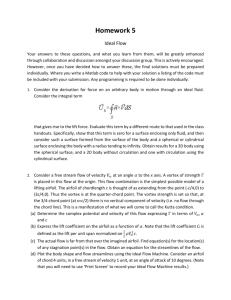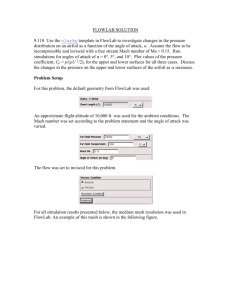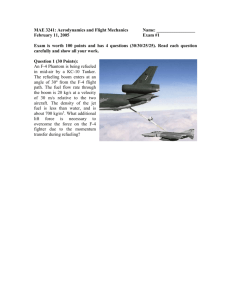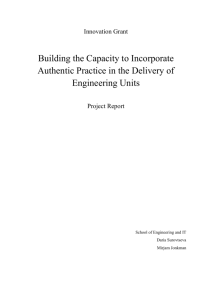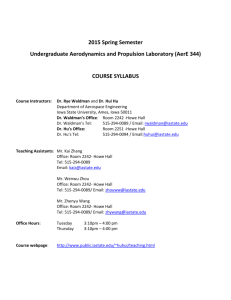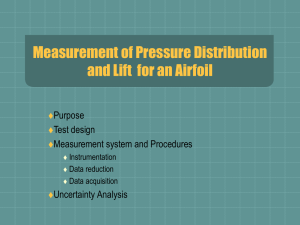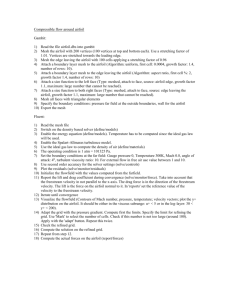avia lab193.Laborato..
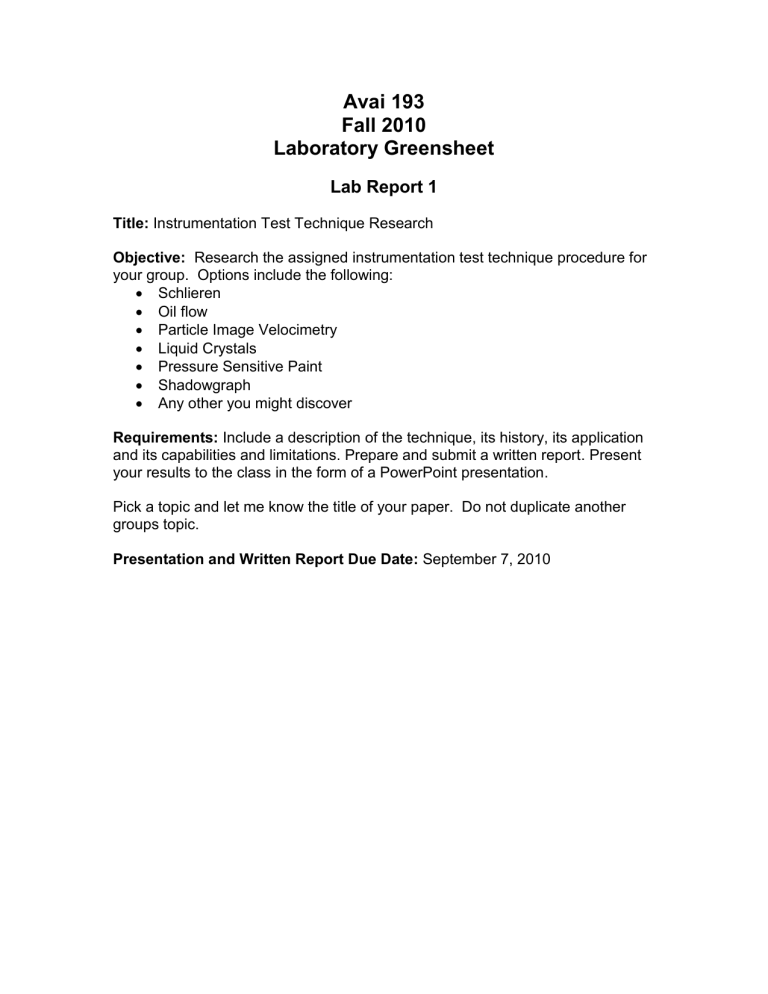
Avai 193
Fall 2010
Laboratory Greensheet
Lab Report 1
Title: Instrumentation Test Technique Research
Objective: Research the assigned instrumentation test technique procedure for your group. Options include the following:
Schlieren
Oil flow
Particle Image Velocimetry
Liquid Crystals
Pressure Sensitive Paint
Shadowgraph
Any other you might discover
Requirements: Include a description of the technique, its history, its application and its capabilities and limitations. Prepare and submit a written report. Present your results to the class in the form of a PowerPoint presentation.
Pick a topic and let me know the title of your paper. Do not duplicate another groups topic.
Presentation and Written Report Due Date: September 7, 2010
Lab Report 2
Title: Two-Dimensional Cylinder - Experimental and Theoretical Study
Objective: Determine the experimental surface pressure and velocity distribution for a two-dimensional cylinder and compare the pressure distribution with the inviscid theoretical results. Operate the tunnel at its fastest speed, i.e. Reynolds number. Compare your experimental results with those on the next page and those obtained by another experimental researcher found on the internet.
Requirements: The two-dimensional model has only a single pressure port that should be connected to the manometer board. The static pressure port on the bottom of the tunnel should also be connected to the manometer board. The cylinder can be rotated in the wind tunnel and the angle of rotation should be noted using the attached scale. The cylinder should be rotated through 180 0 with measurements taken every 10 0 . Take data at the fastest speed the tunnel will operate. Determine the Reynolds number at which the tunnel is operating. Use
Bernoulli’s equation and the hydrostatic equation to determine the surface speed and pressure on the cylinder by creating an Excel spreadsheet. Plot the surface pressure coefficient and speed versus cylinder angle
on two different charts.
Compare the experimental and theoretical pressure distributions with the results on the next page. Do some research to obtain experimental and theoretical results performed by other researchers and compar e your results with their’s.
Prepare a formal report and present your results to the rest of the class.
Presentation and Written Report Due Date: September 28, 2010
Experimental and theoretical pressure coefficient distribution for flow over a circular cylinder as a function of the azimuthal angle
.
Lab Report 3
Title: Symmetric Airfoil Aerodynamics - Experimental and Computational Study
Objective: Determine the surface pressure distribution and lift coefficient for the
NACA 0012 airfoil experimentally and computationally. With the wind tunnel operating at its maximum velocity, choose three different angles of attack, e.g.,
0 0 , 4 0 and 6 0 . Compare the computational and experimental results. Compare your results with those obtained by another experimental researcher.
Requirements: Determine the geometry of the airfoil to be tested by either measuring it or determining it from other sources. Determine the location of the pressure orifices on the airfoil as a percentage of the chord. Get the free-stream total conditions from the “Terrapod Handheld Weather Station,” i.e., barometric pressure and temperature. Determine the static pressure at each orifice using the manometer board, Bernoulli’s equation and the hydrostatic equation by creating an Excel spreadsheet. Calculate the pressure coefficient and surface velocity at each orifice from the pressure data. Plot the pressure coefficient and velocity distribution on the upper and lower surfaces as a function of percentage of chord for each angle of attack.
Numerically determine the lift generated on the airfoil at each angle of attack.
This process will be explained in class.
Obtain numerical results either from a technical report or by using Mathematica
Player and the program “PotentialFlowOverANACAFourDigitAirfoil.nbp.”
Determine the equivalent pressure coefficient distribution and lift coefficient for the same cases obtained experimentally in the lab. Compare the potential flow results with the experimental data you obtained. The computer program can be found on the internet.
Prepare a formal report and present your results to the rest of the class.
Presentation and Written Report Due Date: October 12, 2010
Lab Report 4
Title: Boundary Layer on a Flat Plate
Objective: Determine the boundary layer velocity profiles at five axial stations along a flat with the wind tunnel operating at its maximum velocity. Compare those results with another researcher’s. Compute the local shear stress at each of those stations. Integrate that data to determine the skin friction drag on the top surface of the flat plate. Compare that drag with the theoretical value obtained using the formulas presented in class for a flat plate undergoing laminar, transitional and turbulent flow.
Requirements: Utilize the height of the probes of the boundary layer rake on the flat plate provided by the instructor for your calculations. Select five streamwise locations on the flat plate near the end of the plate at which the boundary layer rake will be positioned for the experiment. Mount the flat plate in the wind tunnel and connect it to the manometer board noting which probe of the rake is connected to which manometer tube. Get the free-stream total conditions from the San Jose ATIS, i.e., barometric pressure and temperature.
Note the tunnel-off manometer board reading and tunnel on static pressure manometer board reading.
Take the readings on the manometer board for each probe of the rake at each streamwise location. Reduce that data to determine the velocity distribution throughout the boundary layer at each streamwise location. Calculate the velocity gradient at the wall using that data and the subsequent shear stress.
Using the average shear stress, estimate the skin-friction drag on the flat plate.
Compare that result with the theoretical value based on formulas presented in class for both a laminar/turbulent and turbulent flow conditions.
Prepare a formal report and present your results to the rest of the class.
Presentation and Written Report Due Date: November 9, 2010
Lab Report 5
Title: Asymmetric Airfoil Aerodynamics - Experimental and Computational Study
Objective: Determine the surface pressure distribution and lift coefficient for the
NACA 4412 airfoil experimentally and computationally. With the wind tunnel operating at its maximum velocity, choose three different angles of attack, e.g.,
0 0 , 4 0 and 6 0 . Compare the computational and experimental results. Compare your results with those obtained by another researcher.
Requirements: Determine the geometry of the airfoil to be tested by either measuring it or determining it from other sources. Determine the location of the pressure orifices on the top and bottom surfaces of the airfoil as a percentage of the chord. Get the free-stream total conditions from the “Terrapod Handheld
Weather Station,
” i.e., barometric pressure and temperature. Determine the static pressure at each orifice using the manometer board, Bernoulli’s equation and the hydrostatic equation by creating an Excel spreadsheet. Calculate the pressure coefficient and surface velocity at each orifice. Plot the pressure coefficient and velocity distribution on the upper and lower surfaces as a function of percentage of chord for each angle of attack.
Numerically determine the lift generated on the airfoil at each angle of attack.
This process will be explained in class.
Obtain numerical results either from a technical report or by using Mathematica
Player and the program “PotentialFlowOverANACAFourDigitAirfoil.nbp.”
Determine the equivalent pressure coefficient distribution and lift coefficient for the same cases obtained experimentally in the lab. Compare the potential flow results with the experimental data you obtained. The computer program can be found on the internet.
Prepare a formal report and present your results to the rest of the class.
Presentation and Written Report Due Date: November 23, 2009
Lab Report 6
Title: Aerodynamic Effects of Airfoil Icing
Objective: Determine the surface pressure distribution and lift coefficient for the
NACA 4412 airfoil experimentally and computationally with a layer of simulated ice along the leading edge. Run the wind tunnel at the maximum speed possible for three different angles of attack, e.g., 0 0 , 4 0 and 6 0 . Compare your experimental results with those you obtained for this airfoil without the simulated ice.
Requirements: Determine the geometry of the airfoil to be tested by either measuring it or determining it from other sources. Determine the location of the pressure orifices on the airfoil as a percentage of the chord. Get the free-stream total conditions from the Handheld Weather Station in the laboratory, i.e., barometric pressure and temperature. Determine the static pressure at each orifice using the manometer board, Bernoulli’s equation and the hydrostatic equation by creating an Excel spreadsheet. Calculate the pressure coefficient at each orifice from the pressure data. Plot the pressure coefficient on the upper and lower surfaces as a function of percentage of chord for the airfoil with and without the simulated ice.
Numerically determine the lift generated on the airfoil with ice for each speed and at each angle of attack. This process will be explained in class. Compare these results with those you obtained for the airfoil without the simulated ice.
Prepare a formal report and present your results to the rest of the class.
Presentation and Written Report Due Date: December 7, 2010
